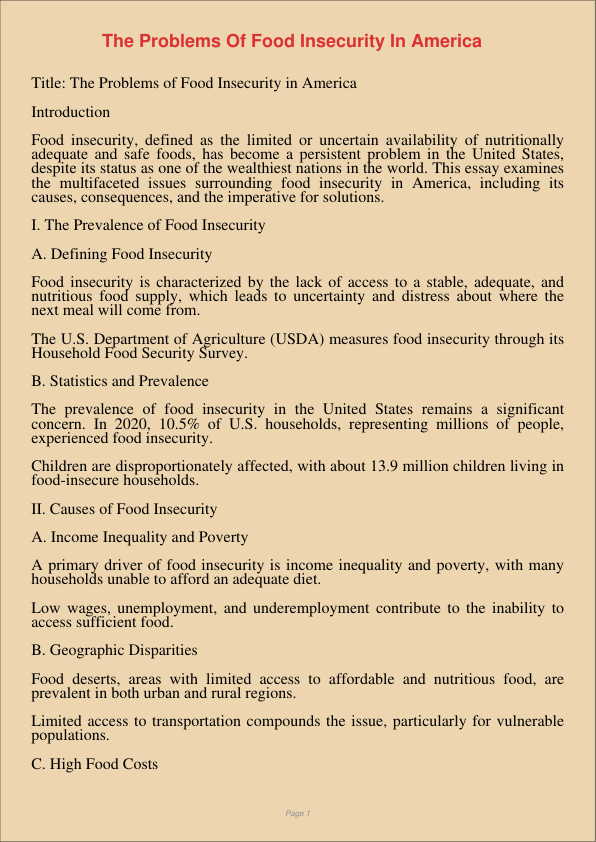The Problems Of Food Insecurity In America
Jan 8, 2024
food insecurity
problems
Visual Arts & Film Studies
Journalism & Communication
Title: The Problems of Food Insecurity in America
Introduction
Food insecurity, defined as the limited or uncertain availability of nutritionally adequate and safe foods, has become a persistent problem in the United States, despite its status as one of the wealthiest nations in the world. This essay examines the multifaceted issues surrounding food insecurity in America, including its causes, consequences, and the imperative for solutions.
I. The Prevalence of Food Insecurity
A. Defining Food Insecurity
Food insecurity is characterized by the lack of access to a stable, adequate, and nutritious food supply, which leads to uncertainty and distress about where the next meal will come from.
The U.S. Department of Agriculture (USDA) measures food insecurity through its Household Food Security Survey.
B. Statistics and Prevalence
The prevalence of food insecurity in the United States remains a significant concern. In 2020, 10.5% of U.S. households, representing millions of people, experienced food insecurity.
Children are disproportionately affected, with about 13.9 million children living in food-insecure households.
II. Causes of Food Insecurity
A. Income Inequality and Poverty
A primary driver of food insecurity is income inequality and poverty, with many households unable to afford an adequate diet.
Low wages, unemployment, and underemployment contribute to the inability to access sufficient food.
B. Geographic Disparities
Food deserts, areas with limited access to affordable and nutritious food, are prevalent in both urban and rural regions.
Limited access to transportation compounds the issue, particularly for vulnerable populations.
C. High Food Costs
Rising food costs and the relative expense of healthy, fresh produce can make it difficult for individuals and families to maintain a balanced diet.
This problem is compounded by marketing strategies that often promote unhealthy, processed foods.
III. Consequences of Food Insecurity
A. Health Implications
Food insecurity is linked to numerous health problems, including malnutrition, obesity, diabetes, and hypertension.
Children from food-insecure households may experience developmental delays and poorer educational outcomes.
B. Economic and Societal Costs
The economic impact of food insecurity includes increased healthcare costs, reduced workforce productivity, and greater reliance on social safety net programs.
Societal costs include the perpetuation of cycles of poverty and the undermining of social cohesion.
IV. Solutions to Food Insecurity
A. Increase Income and Employment Opportunities
Raising the minimum wage and creating job opportunities that provide livable wages are essential steps in addressing food insecurity.
Income support programs, such as the Earned Income Tax Credit (EITC), can also mitigate the impact of food insecurity.
B. Enhance Access to Nutritious Food
Expand the availability of affordable and nutritious foods in food deserts by incentivizing grocery stores and farmers’ markets to operate in underserved areas.
Promote community gardens and urban agriculture initiatives.
C. Educational and Awareness Programs
Implement educational programs that teach individuals and families about nutrition, cooking skills, and budget management.
Raise awareness about food insecurity to reduce stigma and encourage community support.
D. Strengthen Social Safety Nets
Enhance and protect safety net programs like the Supplemental Nutrition Assistance Program (SNAP) to provide a more reliable source of assistance.
Improve the application and enrollment processes for these programs to reach more eligible individuals.
Conclusion
Food insecurity in America is a multifaceted issue that arises from income inequality, limited access to nutritious food, and high food costs. Its consequences have far-reaching implications for public health, the economy, and societal well-being. Addressing food insecurity requires a combination of income support, access to nutritious food, educational programs, and the strengthening of social safety nets. The challenge of reducing food insecurity in the United States is not just a matter of ensuring food on the table but also of upholding the fundamental right to food and dignity for all its citizens.
